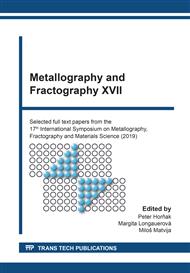p.3
p.11
p.19
p.26
p.33
p.43
p.48
p.54
Metallographic Documentation of the Degradation of Iron and Nickel Based Alloys in HCl and H2S Containing Environments, between 480 – 680 °C
Abstract:
Corrosion behavior of the alloys 1.7386 (P9), 1.4462, 1.4841, 1.4959 (Alloy 800HT) and 2.4816 (Alloy 600) was tested for 24, 72 and 240 h between 480 – 680 °C. The testing gas atmosphere contained 3.8 vol. % HCl, 200 ppm H2S and CO, CO2 and N2. It simulated conditions present in a thermal cracking process for post-consumer plastics. Samples were analyzed by metallography, SEM/EDX and XRD after corrosion experiments. Additionally, their mass loss during the test was evaluated. A multilayered structure of corrosion products grew on the samples during the corrosion experiments. The composition of the corrosion products depended not on the material, but on the testing temperature. At 680 °C chromium sulphide formed the outer layer, followed by a chromium oxide layer. Below these two layers a chlorine containing layer was observed. At 480 °C mainly nickel sulphide was detected, besides chromium oxide and iron- and chromium chloride. Especially at higher testing temperatures FeCl2 was not observed directly on the samples, but as colorless crystals at the colder parts of the testing equipment. At 680 °C the mass loss of the samples decreased with increasing nickel content. However, this effect changed entirely at lower testing temperatures. At 480 °C 1.7386 and 2.4816 showed nearly the same mass losses.
Info:
Periodical:
Pages:
26-32
Citation:
Online since:
November 2020
Authors:
Keywords:
Price:
Сopyright:
© 2020 Trans Tech Publications Ltd. All Rights Reserved
Share:
Citation:


